

 |
Search the Site with

|
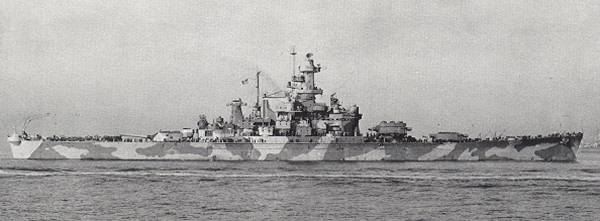 | Sorry, no coat of arms available. |
USS ALABAMA was the fourth and final SOUTH DAKOTA - class Battleship and the third ship in the Navy named after the state. Decommissioned after 4 1/2 years of service, the ALABAMA spent the next years at the Bremerton Group, United States Pacific Reserve Fleet, at Bremerton, Wash, until stricken from the Navy list on June 1, 1962. On June 16, 1964, the ALABAMA was donated to the "USS ALABAMA Battleship Commission" and was subsequently towed to her permanent berth at Mobile, Ala., arriving in Mobile Bay on 14 September 1964. There, she serves as a museum.
| General Characteristics: | Keel laid: February 1, 1940 |
| Launched: February 16, 1942 | |
| Commissioned: August 16, 1942 | |
| Decommissioned: January 9, 1947 | |
| Builder: Norfolk Naval Shipyard, Norfolk, Va. | |
| Propulsion system: boilers, four Westinghouse geared turbines | |
| Propellers: four | |
| Length: 680.8 feet (207.5 meters) | |
| Beam: 108 feet (32.9 meters) | |
| Draft: 36 feet (11 meters) | |
| Displacement: Light: approx. 38,000 tons | |
| Full: approx. 44,374 tons | |
| Speed: 28 knots | |
| Aircraft: three planes | |
| Catapults: two | |
| Crew: 2354 (War), 1793 (Peace) | |
| Last armament: Nine 16-inch / 45 caliber guns; twenty 5-inch / 38 caliber guns; twenty-four 40 mm guns and twenty-two 20 mm guns |
Crew List:
This section contains the names of sailors who served aboard USS ALABAMA. It is no official listing but contains the names of sailors who submitted their information.
USS ALABAMA Cruise Books:
Accidents aboard USS ALABAMA:
| Date | Where | Events |
|---|---|---|
| February 21, 1944 | Marianas, Pacific | While repelling enemy air attacks during strikes on Tinian, Saipan and Guam, 5-inch mount no. 9 accidentally fires into mount no. 5. Five men died, and 11 were wounded in the mishap. |
History of USS ALABAMA:
USS ALABAMA was laid down on 1 February 1940 by the Norfolk (Va.) Navy Yard; launched on 16 February 1942; sponsored by Mrs. Lister Hill, wife of the senior Senator from Alabama; and commissioned on 16 August 1942, Capt. George B. Wilson in command.
After fitting out, ALABAMA commenced her shakedown cruise in Chesapeake Bay on Armistice Day (11 November) 1942. As the year 1943 began, the new battleship headed north to conduct operational training out of Casco Bay, Maine. She returned to Chesapeake Bay on 11 January 1943 to carry out the last week of shakedown training. Following a period of availability and logistics support at Norfolk, ALABAMA was assigned to Task Group (TG) 22.2, and returned to Casco Bay for tactical maneuvers on 13 February 1943.
With the movement of substantial British strength toward the Mediterranean theater, to prepare for the invasion of Sicily, the Royal Navy lacked the heavy ships necessary to cover the northern convoy routes. The British appeal for help on those lines soon led to the temporary assignment of ALABAMA and USS SOUTH DAKOTA (BB 57) to the Home Feet.
On 2 April 1943, ALABAMA - as part of Task Force 22 sailed for the Orkney Islands with her sister ship and a screen of five destroyers. Proceeding via Little Placentia Sound, Argentia, Newfoundland, the battleship reached Scapa Flow on 19 May 1943, reporting for duty with TF 61 and becoming a unit of the British Home Fleet. She soon embarked on a period of intensive operational training to coordinate joint operations.
Early in June, ALABAMA and her sister ship, along with British Home Fleet units, covered the reinforcement of the garrison on the island of Spitzbergen, which lay on the northern flank of the convoy route to Russia, in an operation that took the ship across the Arctic Circle. Soon after her return to Scapa Flow, she was inspected by Admiral Harold R. Stark, Commander, United States Naval Forces, Europe.
Shortly thereafter, in July, ALABAMA participated in Operation Governor, a diversion aimed toward southern Norway, to draw German attention away from the real Allied thrust, toward Sicily. It had also been devised to attempt to lure out the German battleship TIRPITZ, the sister ship of the famed, but short-lived, BISMARCK, but the Germans did not rise to the challenge, and the enemy battleship remained in her Norwegian lair.
ALABAMA was detached from the British Home Fleet on 1 August 1943, and, in company with SOUTH DAKOTA and screening destroyers, sailed for Norfolk, arriving there on 9 August. For the next ten days, ALABAMA underwent a period of overhaul and repairs. This work completed, the battleship departed Norfolk on 20 August 1943 for the Pacific. Transiting the Panama Canal five days later, she dropped anchor in Havannah Harbor, at Efate, in the New Hebrides, on 14 September.
Following a month and a half of exercises and training, with fast carrier task groups, the battleship moved to Fiji on 7 November. ALABAMA sailed on 11 November 1943 to take part in Operation Galvanic, the assault on the Japanese-held Gilbert Islands. She screened the fast carriers as they launched attacks on Jaluit and Mille atolls, Marshall Islands, to neutralize Japanese airfields located there. ALABAMA supported landings on Tarawa on 20 November and later took part in the securing of Betio and Makin. On the night of 26 November, ALABAMA twice opened fire to drive off enemy aircraft that approached her formation.
On 8 December 1943, ALABAMA, along with five other fast battleships, carried out the first Pacific gunfire strike conducted by that type of warship. ALABAMA's guns hurled 535 rounds into enemy strong points, as she and her sister ships bombarded Nauru Island, an enemy phosphate-producing center, causing severe damage to shore installations there. She also took the destroyer USS BOYD (DD 644), alongside after that ship had received a direct hit from a Japanese shore battery on Nauru, and brought three injured men on board for treatment.
She then escorted the carriers USS BUNKER HILL (CV 17) and USS MONTEREY (CVL 26) back to Efate, arriving on 12 December. ALABAMA departed the New Hebrides for Pearl Harbor on 5 January 1944, arrived on the 12th, and underwent a brief drydocking at the Pearl Harbor Navy Yard. After replacement of her port outboard propeller, and routine maintenance, ALABAMA was again underway to return to action in the Pacific.
ALABAMA reached Funafuti, Ellice Islands, on 21 January 1944, and there rejoined the fleet. Assigned to Task Group (TG) 58.2, which was formed around ESSEX (CV 9), ALABAMA left the Ellice Islands on 25 January to help carry out Operation Flintlock, the invasion of the Marshall Islands. ALABAMA, along with sister ship SOUTH DAKOTA and the fast battleship USS NORTH CAROLINA (BB 55), bombarded Roi on 29 January and Namur on 30 January; she hurled 330 rounds of 16-inch and 1,562 of 5-inch toward Japanese targets, destroying planes, airfield facilities, blockhouses, buildings, and gun emplacements. Over the following days of the campaign, ALABAMA patrolled the area north of Kwajalein Atoll. On 12 February 1944, ALABAMA sortied with the BUNKER HILL task group to launch attacks on Japanese installations, aircraft and shipping at Truk. Those raids, launched on 16 and 17 February, caused heavy damage to enemy shipping concentrated at that island base.
Leaving Truk ALABAMA began steaming toward the Marianas to assist in strikes on Tinian, Saipan and Guam. During this action, while repelling enemy air attacks on 21 February 1944, 5-inch mount no. 9 accidentally fired into mount no. 5. Five men died, and 11 were wounded in the mishap.
After the strikes were completed on 22 February, ALABAMA conducted a sweep looking for crippled enemy ships southeast of Saipan, and eventually returned to Majuro on 26 February 1944. There she served temporarily as flagship for Vice Admiral Marc A. Mitscher, Commander, TF 58, from 3 to 8 March.
ALABAMA's next mission was to screen the fast carriers as they hurled air strikes against Japanese positions on Palau, Yap, Ulithi, and Woleai, Caroline Islands. She steamed from Majuro on 22 March 1944 with TF 58 in the screen of USS YORKTOWN (CV 10), On the night of 29 March, about six enemy planes approached TG 58.3, in which ALABAMA was operating, and four broke off to attack ships in the vicinity of the battleship. ALABAMA downed one unassisted, and helped in the destruction of another.
On 30 March, planes from TF 58 began bombing Japanese airfields, shipping, fleet servicing facilities, and other installations on the islands of Palau, Yap, Ulithi and Woleai. During that day, ALABAMA again provided antiaircraft fire whenever enemy planes appeared. At 2044 on the 30th, a single plane approached TG 58.3, but ALABAMA and other ships drove it off before it could cause any damage.
The battleship returned briefly to Majuro, before she sailed on 13 April with TF 58, this time in the screen of USS ENTERPRISE (CV 6). In the next three weeks, TF 58 hit enemy targets on Hollandia, Wakde, Sawar, and Sarmi along the New Guinea coast; covered Army landings at Aitape, Tanahmerah Bay, and Humboldt Bay; and conducted further strikes on Truk.
As part of the preliminaries to the invasion of the Marianas, ALABAMA, in company with five other fast battleships, shelled the large island of Ponape, in the Carolines, the site of a Japanese airfield and sea lane base. As ALABAMA's Capt. Fred T. Kirtland subsequently noted, the bombardment, of 70 minutes' duration, was conducted in a "leisurely manner." ALABAMA then returned to Majuro on 4 May 1944 to prepare for the invasion of the Marianas.
After a month spent in exercises and refitting, ALABAMA again got under way with TF 58 to participate in Operation Forager. On 12 June, ALABAMA screened the carriers striking Saipan. On 13 June, ALABAMA took part in a six-hour preinvasion bombardment of the west coast of Saipan, to soften the defenses and cover the initial minesweeping operations. Her spotting planes reported that her salvoes had caused great destruction and fires in Garapan town. Though the shelling appeared successful, it proved a failure due to the lack of specialized training and experience required for successful shore bombardment. Strikes continued as troops invaded Saipan on 15 June.
On 19 June, during the Battle of the Philippine Sea, ALABAMA operated with TG 58.7, providing antiaircraft support for the fast carriers against attacking Japanese aircraft. The ships of TF 58 claimed 27 enemy planes downed during the course of the action which later came to be known as the "Marianas Turkey Shoot."
In the first raid that approached ALABAMA's formation, only two planes managed to penetrate to attack her sister ship SOUTH DAKOTA, scoring one bomb hit that caused minor damage. An hour later a second wave, composed largely of torpedo bombers, bore in, but ALABAMA's barrage discouraged two planes from attacking SOUTH DAKOTA. The intense concentration paid to the incoming torpedo planes left one dive bomber nearly undetected, and it managed to drop its load near ALABAMA; the two small bombs were near-misses, and caused no damage.
American submarines sank two Japanese carriers and Navy pilots claimed a third carrier. American pilots and antiaircraft gunners had seriously depleted Japanese naval air power. Out of the 430 planes with which the enemy had commenced the Battle of the Philippine Sea, only 35 remained operational afterward.
ALABAMA continued patrolling areas around the Marianas to protect the American landing forces on Saipan, screening the east carriers as they struck enemy shipping, aircraft, and shore installations on Guam, Tinian, Rota, and Saipan. She then retired to the Marshalls for upkeep.
ALABAMA - as flagship for Rear Admiral E. W. Hanson, Commander, Battleship Division 9 - left Eniwetok on 14 July 1944, sailing with the task group formed around USS BUNKER HILL. She screened the fast carriers as they conducted preinvasion attacks and support of the landings on the island of Guam on 21 July. She returned briefly to Eniwetok on 11 August. On 30 August she got underway in the screen of USS ESSEX (CV 9) to carry out Operation Stalemate II, the seizure of Palau, Ulithi, and Yap. On 6 through 8 September, the forces launched strikes on the Carolinas.
ALABAMA departed the Carolines to sail to the Philippines and provided cover for the carriers striking the islands of Cebu, Leyte, Bohol and Negros from 12 to 14 September. The carriers launched strikes on shipping and installations in the Manila Bay area on 21 and 22 September, and in the central Philippines area on 24 September. ALABAMA retired briefly to Saipan on 28 September, then proceeded to Ulithi on 1 October 1944.
On 6 October 1944 ALABAMA sailed with TF 38 to support the liberation of the Philippines. Again operating as part of a fast carrier task group, ALABAMA protected the flattops while they launched strikes on Japanese facilities at Okinawa, in the Pescadores and Formosa.
Detached from the Formosa area on 14 October to sail toward Luzon, the fast battleship again used her antiaircraft batteries in support of the carriers as enemy aircraft attempted to attack the formation. ALABAMA's gunners claimed three enemy aircraft shot down and a fourth damaged. By 15 October, ALABAMA was supporting landing operations on Leyte. She then screened the carriers as they conducted air strikes on Cebu, Negros, Panay, northern Mindanao, and Leyte on 21 October 1944.
ALABAMA, as part of the ENTERPRISE screen, supported air operations against the Japanese Southern Force in the area off Suriago Strait then moved north to strike the powerful Japanese Central Force heading for San Bernardino Strait. After receiving reports of a third Japanese force, the battleship served in the screen of the fast carrier task force as it sped to Cape Engano. On 24 October, although American air strikes destroyed four Japanese carriers in the Battle off Cape Engano, the Japanese Central Force under Admiral Kurita had transited San Bernardino Strait and emerged off the coast of Samar, where it fell upon a task group of American escort carriers and their destroyer and destroyer escort screen. ALABAMA reversed her course and headed for Samar to assist the greatly outnumbered American forces, but the Japanese had retreated by the time she reached the scene. She then joined the protective screen for the ESSEX task group to hit enemy forces in the central Philippines before retiring to Ulithi on 30 October 1944 for replenishment.
Underway again on 3 November 1944, ALABAMA screened the fast carriers as they carried out sustained strikes against Japanese airfields, and installations on Luzon to prepare for a landing on Mindoro Island. She spent the next few weeks engaged in operations against the Visayas and Luzon before retiring to Ulithi on 24 November.
The first half of December 1944 found ALABAMA engaged in various training exercises and maintenance routines. She left Ulithi on 10 December, and reached the launching point for air strikes on Luzon on 14 December, as the fast carrier task forces launched aircraft to carry out preliminary strikes on airfields on Luzon that could threaten the landings slated to take place on Mindoro. From 14 to 16 December, a veritable umbrella of carrier aircraft covered the Luzon fields, preventing any enemy planes from getting airborne to challenge the Mindoro-bound convoys. Having completed her mission, she left the area to refuel on 17 December; but, as she reached the fueling rendezvous, began encountering heavy weather. By daybreak on the 18th, rough seas and harrowing conditions rendered a fueling at sea impossible; 50 knot winds caused ships to roll heavily. ALABAMA experienced rolls of 30 degrees, had both her Vought Kingfisher float planes so badly damaged that they were of no further value, and received minor damage to her structure. At one point in the typhoon, ALABAMA recorded wind gusts up to 83 knots. Three destroyers, USS HULL (DD 350), USS MONAGHAN (DD 354), and USS SPENCE (DD 512), were lost to the typhoon. By 19 December, the storm had run its course; and ALABAMA arrived back at Ulithi on 24 December. After pausing there briefly, ALABAMA continued on to Puget Sound Naval Shipyard, for overhaul.
The battleship entered drydock on 18 January 1945, and remained there until 25 February. Work continued until 17 March, when ALABAMA got underway for standardization trials and refresher training along the southern California coast. She got underway for Pearl Harbor on 4 April, arrived there on 10 April, and held a week of training exercises. She then continued on to Ulithi and moored there on 28 April 1945.
ALABAMA departed Ulithi with TF 58 on 9 May 1945, bound for the Ryukyus, to support forces which had landed on Okinawa on 1 April 1945, and to protect the fast carriers as they launched air strikes on installations in the Ryukyus and on Kyushu. On 14 May, several Japanese planes penetrated the combat air patrol to get at the carriers; one crashed Vice Admiral Mitscher's flagship. ALABAMA's guns splashed two, and assisted in splashing two more.
Subsequently, ALABAMA rode out a typhoon on 4 and 5 June, suffering only superficial damage while the nearby heavy cruiser USS PITTSBURGH (CA 70) lost her bow. ALABAMA subsequently bombarded the Japanese island of Minami Daito Shima, with other fast battleships, on 10 June 1945 and then headed for Leyte Gulf later in June to prepare to strike at the heart of Japan with the 3rd Fleet.
On 1 July 1945, ALABAMA and other Third Fleet units got underway for the Japanese home islands. Throughout the month of July 1945, ALABAMA carried out strikes on targets in industrial areas of Tokyo and other points on Honshu, Hokkaido, and Kyushu; on the night of 17 and 18 July, ALABAMA, and other fast battleships in the task group, carried out the first night bombardment of six major industrial plants in the Hitachi-Mito area of Honshu, about eight miles northeast of Tokyo. On board ALABAMA to observe the operation was retired Rear Admiral Richard E. Byrd, the famed polar explorer.
On 9 August, ALABAMA transferred a medical party to the destroyer USS AULT (DD 698), for further transfer to the destroyer BORIE (DD 704). The latter had been kamikazied on that date and required prompt medical aid on her distant picket station.
The end of the war found ALABAMA still at sea, operating off the southern coast of Honshu. On 15 August 1945, she received word of the Japanese capitulation. During the initial occupation of the Yokosuka-Tokyo area, ALABAMA transferred detachments of marines and bluejackets for temporary duty ashore; her bluejackets were among the first from the fleet to land. She also served in the screen of the carriers as they conducted reconnaissance flights to locate prisoner-of-war camps.
ALABAMA entered Tokyo Bay on 5 September to receive men who had served with the occupation forces, and then departed Japanese waters on 20 September. At Okinawa, she embarked 700 sailors - principally members of Navy construction battalions (or "Seabees") for her part in the "Magic Carpet" operations. She reached San Francisco at mid-day on 15 October, and on Navy Day (27 October 1945) hosted 9,000 visitors. She then shifted to San Pedro, Calif., on 29 October. ALABAMA remained at San Pedro through 27 February 1946, when she left for the Puget Sound Naval Shipyard for inactivation overhaul. ALABAMA was decommissioned on 9 January 1947, at the Naval Station, Seattle, and was assigned to the Bremerton Group, United States Pacific Reserve Fleet. She remained there until struck from the Naval Vessel Register on 1 June 1962.
Citizens of the state of Alabama had formed the "USS ALABAMA Battleship Commission" to raise funds for the preservation of ALABAMA as a memorial to the men and women who served in World War II. The ship was awarded to that state on 16 June 1964, and was formally turned over on 7 July 1964 in ceremonies at Seattle. ALABAMA was then towed to her permanent berth at Mobile, Ala., arriving in Mobile Bay on 14 September 1964.
ALABAMA received nine battle stars for her World War II service.
USS ALABAMA Image Gallery:
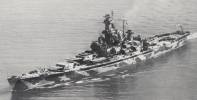 |  | 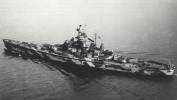 | 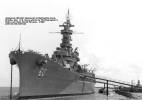 |
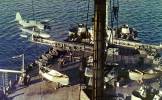 | 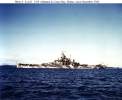 |
The photos below were taken by Michael Jenning during a visit to the USS ALABAMA Museum in Mobile, Ala,. on October 17, 2019.
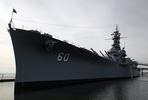 | 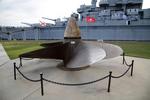 | 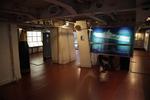 |  | 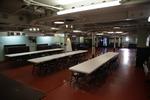 |
 | 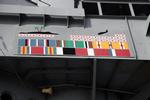 | 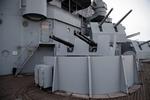 | 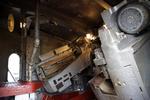 |  |
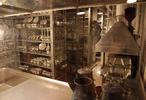 | 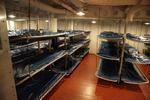 | 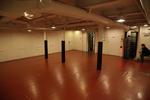 | Click here for more Photos. | |
 Back to Battleships list.
Back to Battleships list.  Back to ships list.
Back to ships list.  Back to selection page.
Back to selection page.  Back to 1st page.
Back to 1st page.